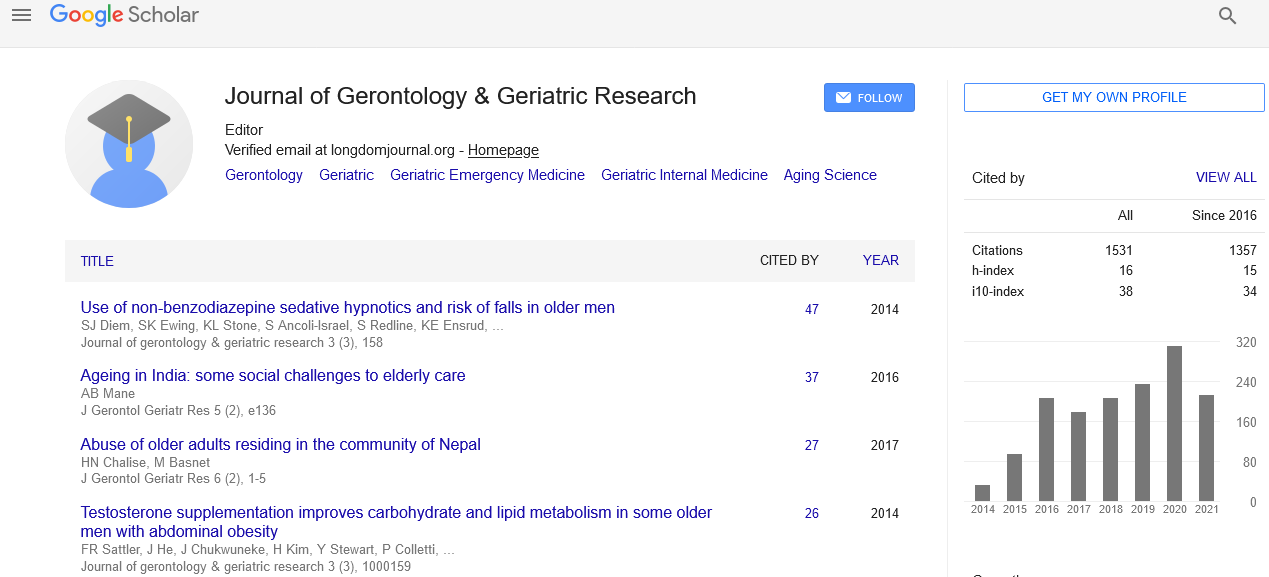PMC/PubMed Indexed Articles
Indexed In
- Open J Gate
- Genamics JournalSeek
- SafetyLit
- RefSeek
- Hamdard University
- EBSCO A-Z
- OCLC- WorldCat
- Publons
- Geneva Foundation for Medical Education and Research
- Euro Pub
- Google Scholar
Useful Links
Share This Page
Journal Flyer

Open Access Journals
- Agri and Aquaculture
- Biochemistry
- Bioinformatics & Systems Biology
- Business & Management
- Chemistry
- Clinical Sciences
- Engineering
- Food & Nutrition
- General Science
- Genetics & Molecular Biology
- Immunology & Microbiology
- Medical Sciences
- Neuroscience & Psychology
- Nursing & Health Care
- Pharmaceutical Sciences
Commentary - (2021) Volume 10, Issue 9
Prognostic Biomarkers of Parkinson's Disease
Tripathy Mahendra*Received: 09-Sep-2021 Published: 30-Sep-2021, DOI: 10.35248/2167-7182.20.10.575
Commentary
Parkinson's disease (PD) is a neurodegenerative condition marked by the death of dopaminergic neurons in the substantianigra as well as the appearance of Lewy bodies. Motor and cognitive deficits are caused by such neurological changes. Bradykinesia, resting tremor, muscle rigidity, balance issues, and postural abnormalities are all motor signs. Non-motor symptoms are seen in people with Parkinson's disease, which is characterised by behavioural changes, sensory abnormalities, autonomic dysfunction, sleep problems, dementia, psychosis, sadness, anxiety, anhedonia, pain, and exhaustion due to neurodegeneration.
PD is a long-term, progressive disease that has immunological, genetic, and environmental causes. It is, along with Alzheimer's disease, one of the most common neurodegenerative conditions, affecting about 2% of adults over the age of 60. The existence of parkinsonian motor symptoms is used to diagnose PD, and therapy is just symptomatic and cannot stop or delay the development of the disease. Because typical PD motor symptoms show when more than 80% of dopaminergic function has been lost, identifying biomarkers for early diagnosis could substantially alter diagnosis and therapy approaches. Several approaches to early diagnosis of PD have already been proposed, including Positron Emission Tomography (PET) and Single-Photon Emission Computed Tomography (SPECT) imaging, examining olfactory alterations that usually appear before any known motor symptoms, skin and colonic biopsy, gene sequencing, and changed metabolites, such as uric acid, glutathione, and synuclein.
Metabolomics is a well-defined strategy to uncovering prospective metabolic biomarkers to diagnose Parkinson's disease when no symptoms have yet shown, to better understand the illness's early pathophysiological pathways, to find potential innovative medications, and to track the therapy outcome. Several novel metabolomics investigations have been carried out using various biological materials in attempt to identify possible biomarkers and altered metabolic pathways in Parkinson's disease. This shows that several metabolic pathways are involved in the development and pathophysiology of Parkinson's disease. Alterations in these metabolic pathways were detected in the early, mid, and advanced stages of Parkinson's disease using several analytical techniques.
In PD pathogenesis, altered amino acid, glycine, tryptophan, phenylalanine, leucine, and isoleucine metabolism, TCA cycle dysregulation, fatty acid, purine, and dopamine metabolism are all involved. Because of their relationship with dopamine, metabolites involved in glycine and phenylalanine metabolism play a crucial role. This molecule has a role in the aetiology of Parkinson's disease, particularly in the early stages, and changes in tryptophan metabolism have been linked to mitochondrial dysfunction, mental symptoms, and changes in brain metabolism. The involvement of mitochondrial malfunction and oxidative stress may have an impact on fatty acid metabolism, creating disruptions that manifest as changes in fatty acid levels.
Alterations in the levels of specific metabolites, such as glutathione disulfide, ergothioneine, 8-hydroxyguanosine, 8-hydroxy-2′- deoxyguanosine, and the bilirubin/biliverdin ratio, have been linked to oxidative stress in the development of Parkinson's disease. A recent LC–MS metabolomics study using plasma samples from PD patients revealed changes in many metabolite classes, including a significant decrease in the levels of several free fatty acids, cisaconitic acid, and an increase in the levels of several bile acids in the PD cohort, among other things. The TCA cycle, along with other altered metabolic pathways, is linked to the development of Parkinson's disease. Such a change is thought to be the result of a complicated gene-environment interaction. Because of the intricacy of PD, numerous interrelated metabolic pathways are thought to have a role in symptom onset and disease progression.
Citation: Mahendra T (2021) Prognostic Biomarkers of Parkinson's Disease. J Gerontol Geriatr Res. 10: 575
Copyright: © Mahendra T. This is an open-access article distributed under the terms of the Creative Commons Attribution License, which permits unrestricted use, distribution, and reproduction in any medium, provided the original author and source are credited.


